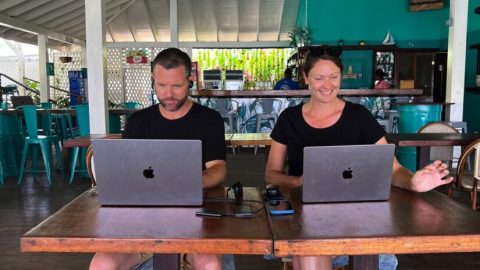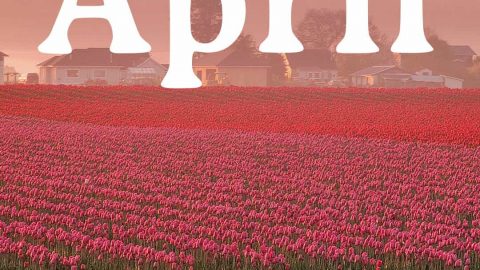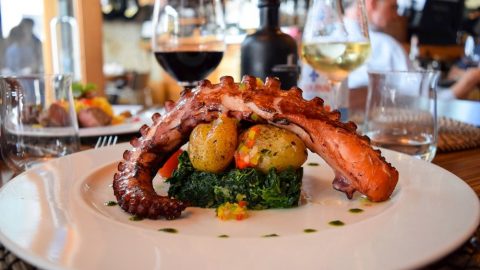(CNN) — The pilot, who is just inches away from his passengers, reaches up and flicks the metallic toggle switches that fire up his engines. Two propellers, visible through the windows on either side, spin noisily into life.
The little aircraft sprints down the gravel for a few hundred meters. Then, as the pilot pulls back on the yoke, it skips into the air and begins banking to the right in a wide turn back on itself. Below, the ground slips away, to be replaced by aquamarine waters.
Loganair flight LM711 isn’t the most comfortable experience.
Eight passengers squeeze into a cabin the size of a VW camper van. Engine noise is relentless. And there are no inflight facilities — if you need the toilet, the only option is to cross your legs. Except there’s no room to cross your legs.
And yet there’s something very special about this flight that, if you didn’t know it before, you’d realize about two minutes into the journey. Because two minutes into the journey, it’s very unlikely that the plane will still be in the air.
This, according to Guinness World Records, is the world’s shortest scheduled airline service, a trip that covers just 1.7 miles (2.7 kilometers) in less time than it takes most passenger airplanes to reach cruising altitude. On a good day, with favorable winds and light luggage, it takes 53 seconds.
The journey, made two to three times daily, connects Westray, an island on the edge of Scotland’s northerly Orkney archipelago, to the smaller, even more remote island of Papa Westray.
Year-round, it’s a lifeline for the 80 or so people who call the four-square-mile island home. In summer, it also brings tourists, mostly day-trippers, seeking to experience the plane ride and discover Papa Westray’s numerous delights.
The real start of the journey for visitors is at the airport that serves Kirkwall, the cheerful capital of Orkney on the archipelago’s largest island, known as Mainland. From here, it’s a quarter-hour flight to Westray before the final record-breaking hop.
It’s in Kirkwall they first climb into the boxy cabin of Loganair’s diminutive Britten Norman BN-2 Islander.
Aviation fans, especially those who manage to snag the first of the four rows of passenger seats, will appreciate being able to watch a pilot at work. But you don’t get to choose where you sit. Allocation is based on evenly distributing weight around the airplane.
Windswept outpost
Takeoff, following a succinct over-the-shoulder safety briefing from the pilot, is a flurry of switches, dials and radio squawks. Watching the spin of the analog altimeter and the tilt of the horizon on the attitude indicator are almost as exciting as the view out of the window.
The window view wins though. It’s early August, so a summer-green patchwork of Orkney farmland alternates with green-blue Atlantic waters as we pass over the islands of Gairsay and Rousay.
After just 15 minutes in the air, the plane lands at Westray Airport, a windswept outpost consisting of a small building, a gravel airstrip and an asphalted taxiway. There’s a brief pause to allow one passenger on for the final, short leg of the trip, and then we’re away.
This is the record-breaking portion of the journey, a flight that is less than the length of the runway at most major airports.
No need for seat back screens showing you the route map — you can look out of the window to see where you’re going to land even before you take off.
With the stopwatch running from the moment wheels are off ground, it turns out to be a slow day for the world’s shortest flight because of the wind direction. It clocks in at just shy of two minutes and 40 seconds.
Landing is another flurry of excitement. We touch down on Papa Westray’s main gravel runway (it has two others mown into grass and wildflowers, to allow for landings when the wind is blowing in the wrong direction), and the island springs to life around us.
There’s a fire truck on standby manned by a pair of brothers who drop their nearby farm work for the duration of the airplane’s visits. Once the plane has departed, the woman staffing the control tower dons a Royal Mail jacket and jumps into a van to deliver the post.
As the plane’s engines fade into the distance, the tiny airport falls silent, the only noise is the stiff sea breeze flapping through the orange windsock overlooking the field. From here, there’s nothing much to see. The treeless island looks bleak and nearly deserted.
It isn’t though. Despite its size, Papa Westray, or Papay as it’s also known, is a truly magical place.
Nobility or witchcraft?
There’s nearly seven hours to kill before the return flight, but plenty to fill it.
Ford starts off with a drive around Papay’s only loop of road, filling us in on local lore and gossip as we pass islanders making industrious use of the seasonal lull in the rough weather they’re often exposed to.
We pass caravans bricked in by cinder blocks to stop them from blowing away. The island’s school (number of pupils: four — two nursery, two primary). Small cottages and larger farmhouses. And acres of arable land hemmed in by hand-built dry stone walls, including one wall painted with red and white stripes to mark it as the end of a runway.
Our first stop is next to Holland Farm, the largest on the island, where a trail through a field of cattle leads down to the coast and an archaeological site known as the Knap of Howar, a 5,000-year-old homestead said to be the oldest standing building in Europe.
It’s an extraordinary spot. Wide open for anyone to explore are the ruins of two connected chambers, sunk into the ground, in which families once lived before even the pyramids of Egypt had been built.
Best of all, in one corner sits a smooth mortar stone on which the Knap’s former occupants crushed grains to make flour. Lying loose atop it, also smooth, is what appears to be the actual pestle that would’ve been used.
Holding something that may have been in the hands of someone on this very spot anywhere up to five millennia ago is a real hairs-on-the-back-of-your-neck moment.
Next stop on the tour is another historic site dating back to the 8th century. St. Boniface is a restored chapel whose step-gabled architecture hints at Hanseatic influences from mainland Europe. In the lichen-covered graveyard is a tombstone whose occupant, says Ford, may be linked to nobility, or perhaps witchcraft.
Last of the great auks
After lunch, we go in search of wildlife on a stroll through Papa Westray’s North Hill Nature Reserve, a coastal heath maintained by the UK’s Royal Society for the Protection of Birds, where some of the dozens of migratory species who visit the island can be spotted.
As we stroll along the shoreline, followed out in the water by a curious grey seal, we see kittiwakes, skuas and a fulmar chick, which we steer well clear of. This gull-like bird is capable of projectile vomiting a foul-smelling substance to ward off predators.
We also visit a sad monument memorializing the great auk, a large flightless bird hunted to extinction in the 19th century. A bird shot on Papa Westray in 1813 is believed to have been the last breeding great auk in the British Isles.
Even on this short coastal walk, the weather is constantly changing. Blue skies are quickly covered by squally rain clouds. The light on the water drifts from gold to silver. It’s a very brief taste of the mercurial temperament that, says Ford, is one of Papay’s main draws.
“I like the fact that things change all the time,” he says. “But you need to be here a certain amount of time to see that, and I like that I can be here over the year to see all the changes that happen, particularly the birds as they come and go with the seasons.
“I also like to experience the polar opposites of the year — the almost 24 hours of daylight in the summer, which has an amazing effect on your body, when you realize you can’t stop working. Everyone gets a bit strung out and you just don’t get tired.”
“That’s really why I came here,” he says. “You really need that sense of community. I don’t think you can live on just birds. I mean you could, but …”
Sideways landings
As the last departure flight of the day draws close, it’s once again time to witness the community in action back at the tiny airport, where firefighting farmers Bobby and David Rendall are once again patrolling the runway in their truck.
Before long, the BN-2’s engines can be heard powering down as senior pilot Colin McAlister, a 17-year veteran of Orkney flying, brings it in for another perfect landing — something he and his fellow pilots can even manage in tricky winter weather conditions, says Ford.
“In summer, they can operate almost on autopilot, but in winter they earn their money,” he says. “I’ve seen the plane landing almost sideways.”
Whatever the season, the plane is a vital connection to the outside world, says Ford.
The island does have a slower boat service, but the air link to Kirkwall means essential medical and social services can be quickly accessed, plus things many of us take for granted such as hairdressers, cafes or jobs. For older children, it’s the school bus.
“It definitely helps me as a means of seeing there’s another world outside the island,” he says.
With McAlister at the controls, the plane is ready for its return journey. This time, with the wind in our favor, it’s a faster ride — close to its maximum speed of 150 mph (240 kph).
Once airborne, every moment brings fresh joy.
Again, there’s the thrill of riding in a small aircraft and watching the pilot deftly handle the controls. There’s the joy of being able to stare straight ahead and see the horizon rushing toward you. And, most of all, there’s the beauty of the Orkney land and seascape.
And then, exactly one minute and eight seconds after our wheels left the ground, we’re back on terra firma.
On the way home, the world’s shortest flight is just that little bit shorter.









Recent Comments